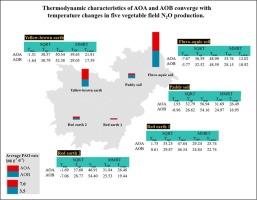长江流域蔬菜土壤中氨氧化古菌和细菌的热力学响应
IF 5
2区 农林科学
Q1 SOIL SCIENCE
引用次数: 0
摘要
氨氧化古菌(AOA)和细菌(AOB)是氧化亚氮(N2O)生成的关键驱动因素。了解它们的热力学响应参数对于在全球变暖情景下制定有效的N2O减缓策略至关重要。然而,AOA和AOB的热力学响应参数与潜在氨氧化(PAO)速率和N2O产量的关系尚不清楚。本研究利用复合缓蚀剂方法评价了AOA和AOB对长江流域典型温室蔬菜土壤中亚硝酸盐(NO2−)和N2O生成的贡献。利用平方根生长(SQRT)和大分子速率理论(MMRT)模型评估了AOA和AOB在5-45°C温度梯度下的热力学响应。结果表明,N2O产量与PAO速率密切相关,不同土壤类型的PAO速率差异显著(0.91 ~ 25.98 μg−1 d−1)。AOA和AOB的理论温度范围分别为- 7.67 ~ 56.94°C和- 7.06 ~ 54.40°C。AOA的最佳活性温度(Topt)显著高于AOB,分别为6.05±2.33°C (SQRT)和6.72±2.34°C (MMRT)。AOA的温度敏感性(Ts_max)高于AOB。综上所述,AOA在高温环境中表现出更高的活性,对温度波动更敏感,表明在全球变暖背景下,AOA对N2O排放的响应更为明显。本文章由计算机程序翻译,如有差异,请以英文原文为准。

Thermodynamic response of ammonia-oxidizing archaea and bacteria in vegetable soils across Yangtze River Basin
Ammonia-oxidizing archaea (AOA) and bacteria (AOB) are key drivers of nitrous oxide (N2O) production. Understanding their thermodynamic response parameters is critical for developing effective N2O mitigation strategies under global warming scenarios. However, the thermodynamic response parameters of AOA and AOB in relation to potential ammonia oxidation (PAO) rates and N2O production remain poorly understood. This study evaluates the contributions of AOA and AOB to nitrite (NO2−) and N2O production in representative greenhouse vegetable soils of the Yangtze River Basin utilizing combined inhibitor approaches. The thermodynamic responses of AOA and AOB were assessed across a temperature gradient of 5–45 °C using the square root growth (SQRT) and macromolecular rate theory (MMRT) models. Results revealed that N2O production was closely linked to PAO rates, which varied significantly (0.91 to 25.98 μg g−1 d−1) among soil types. The theoretical temperature ranges for AOA and AOB were −7.67 to 56.94 °C and −7.06 to 54.40 °C, respectively. AOA demonstrated a significantly higher optimal activity temperature (Topt) than AOB, with differences of 6.05 ± 2.33 °C (SQRT) and 6.72 ± 2.34 °C (MMRT). Furthermore, AOA exhibited greater temperature sensitivity (Ts_max) compared to AOB. In conclusion, AOA demonstrates higher activity in high-temperature environments and greater sensitivity to temperature fluctuations, indicating a more pronounced response to N2O emissions under global warming.
求助全文
通过发布文献求助,成功后即可免费获取论文全文。
去求助
来源期刊

Applied Soil Ecology
农林科学-土壤科学
CiteScore
9.70
自引率
4.20%
发文量
363
审稿时长
5.3 months
期刊介绍:
Applied Soil Ecology addresses the role of soil organisms and their interactions in relation to: sustainability and productivity, nutrient cycling and other soil processes, the maintenance of soil functions, the impact of human activities on soil ecosystems and bio(techno)logical control of soil-inhabiting pests, diseases and weeds.
 求助内容:
求助内容: 应助结果提醒方式:
应助结果提醒方式:


